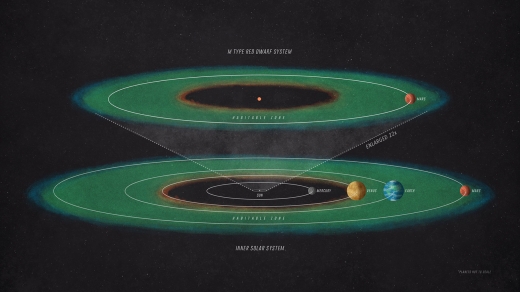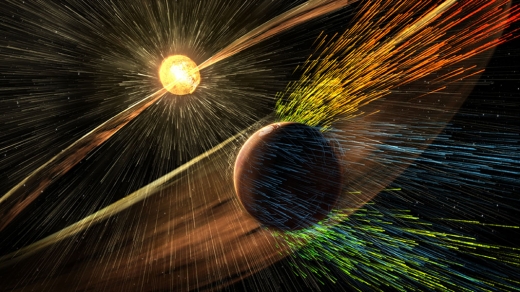Until we can start observing the atmospheres of rocky worlds around red dwarf stars, we’re left to extrapolate conditions there as best we can. New work discussed at the fall meeting of the American Geophysical Union on Dec. 13 recounts one such attempt, using the planet Mars as a surrogate for a similar world in habitable zone orbit around an M-dwarf. The work draws on data from the MAVEN (Mars Atmosphere and Volatile Evolution) mission, launched in 2013 and now orbiting the Red Planet. Designed to study the deterioration of its atmosphere over time, MAVEN offers insights into exoplanets that are derived from plugging in different stellar values.

Image: To receive the same amount of starlight as Mars receives from our Sun, a planet orbiting an M-type red dwarf would have to be positioned much closer to its star than Mercury is to the Sun. Credit: NASA/GSFC.
MAVEN co-investigator David Brain (University of Colorado, Boulder) discussed MAVEN data at the meeting, noting that the planet has lost the bulk of its atmosphere to space through a combination of physical and chemical factors. Aiding the study have been periods of higher and lower solar activity, which have subjected Mars to solar storms, solar flares and coronal mass ejections (CMEs). The processes of atmospheric escape in play led to Brain and team’s calculations on a similar planet positioned at the edge of the habitable zone of a red dwarf.
The results: The tight orbit a planet would need to occupy to be in the habitable zone of a red dwarf would place it much closer to its star than Mercury is to the Sun. Extreme ultraviolet from the host would subject the planet to 5 to 10 times more UV radiation than Mars currently receives. According to the calculations, such a world would lose 3 to 5 times as many charged particles as Mars does in our system, through a process known as ion escape.
But ion escape is only one way to degrade a planetary atmosphere. Photochemical escape refers to the loss of neutral particles when ultraviolet radiation breaks down molecules in the upper atmosphere. The researchers found that this process is 5 to 10 times more effective in the red dwarf scenario, leading to the creation of charged particles that cause ‘sputtering’, where energetic particles are accelerated and create molecular collisions.
Some of the affected molecules, in turn, escape into space, furthering the atmospheric loss. A final process — thermal escape, or Jeans escape — happens to lighter molecules and particularly affects hydrogen, which is lost at the top of the atmosphere. Brain’s team believes that thermal escape would be enhanced if the high UV levels the red dwarf planet would experience push more hydrogen to the top of the atmosphere.

Image: This illustration depicts charged particles from a solar storm stripping away charged particles of Mars’ atmosphere, one of the processes of Martian atmosphere loss studied by NASA’s MAVEN mission, beginning in 2014. Unlike Earth, Mars lacks a global magnetic field that could deflect charged particles emanating from the Sun. Credit: NASA/GSFC.
We wind up with a depressing scenario for habitability, with even a quiet M-class dwarf shortening the habitable period of the planet by a factor as high as 20. A more active M-dwarf, according to this JPL news release, would shorten habitability by a factor of 1,000. The period during which life could arise is drastically shortened and still at the mercy of stellar storms.
But while the researchers see serious habitability issues for a Mars-class planet in this scenario, they point out that a planet with active geology could find its atmosphere replenished, while one with a magnetic field could be shielded to some extent from the effects of the stellar wind. A world of larger size than Mars would also have a larger gravitational field, allowing it to hold on to more of its atmosphere. Mars-like planets, then, are not candidates for habitable conditions even in a red dwarf habitable zone, but different kinds of planets may fare better.



A possible candidate star and world with a ten day year…Can agriculture evolve in a ten day year?
In Earth’s Backyard: New found Alien Planet May Be Good Bet for Life
https://www.space.com › Science & Astronomy
Nov 15, 2017 – Astronomers have spotted a roughly Earth-mass world circling the small, dim star Ross 128, which lies just 11 light-years from the sun. The planet, known as Ross 128b, may have surface temperatures amenable to life as we know it, the researchers announced in a new study that will appear in the journal …
Hopefully Ross 128 has been a “quiet” star for billions of years…
A world without temperate seasons, much like our tropics, would be fine for growing periods that are multi-year. Even temperate, seasonal agriculture has multi-year harvests e.g. trees. There is no reason why life would not work for short year cycles.
These other factors seem far more problematic, at least for terrestrial life. It would make colonization in the open very difficult. But inside domes, or underground, this would be no problem. We will probably have lots of experience with this technology on the Moon, Mars, icy moons, etc. I do have to wonder whether building O’Neills makes far more sense, especially for interstellar colonization. Asteroid belts and planets would be resources to build the habitats. None of KSR’s issues in his novel Aurora would apply to this colonization approach. Robotic mining and construction would allow habitats to be “move-in ready” when the human colonists arrive ( or decanted ).
Maybe for mars sized planets there is more ideal primary.
Maybe a K2-K3 stars are sweet spot, I count 3 advantages for this pair up
1) Much longer time for tide locking effects
2) K.s far less frequent, less intense solar “weather”than M’s
3) Something not so obvious. Surface conditions amenable to
the rise of living organism, would last longer than on larger stars.
So a world like mars(after the heat of formation fades), starting out in slightly frigid conditions, (large polar caps) will warm up due to it’s
primary heating up. But this rate of heating would be slower than G type stars) Once the habitability value induces the formation of life, it is likely to remain there, and for a much longer time than our Mars.
Maybe 2.5-3 billion years of good HZ parameters could be had.
Hello . I don’t understand how a M-class star can emit so much UV rays.
These stars are much colder than the sun , so they must emit less blue et UV light. That’s why they are red ,isn’t it ? I understand they have flares and flares produce UV but in enough quantity as to answer my question ?
M dwarfs emit UV because of the size of the plasma convection currents (cause of magnetic fields and driver of solar storms) path versus its radius.
the Top of the currents lie much closer to the “surface” of the star, than on a larger star. Making flaring much more common. This flaring causes not only UV, but x-ray bursts and higher energy photons
Speaking of the Mars in our Sol system, it may have former farther from Earth than previously thought:
https://phys.org/news/2017-12-mars-earth-early-neighbors.html
Speaking of Mars: ONE: EXTREME methane climate variations increases the chances of life on Mars RIGHT NOW! I REALLY like this one, because it limits the options down to JUST TWO, and the OTHER(non-biological)one, in my opinion, is; BY FAR, the most CONTRIVED one! TWO: possible REAL(i.e. NOT peridolia induced)evidence for past MULTI-CELLULAR(!!!???)life on Mars!!! Biotubation-like structures look EXACTLY like ones found on Earth(i.e. earthworm hollows)BOTH IN SIZE AND SHAPE!!! For details, log on to the Planetaria website(http://planetaria.ca).